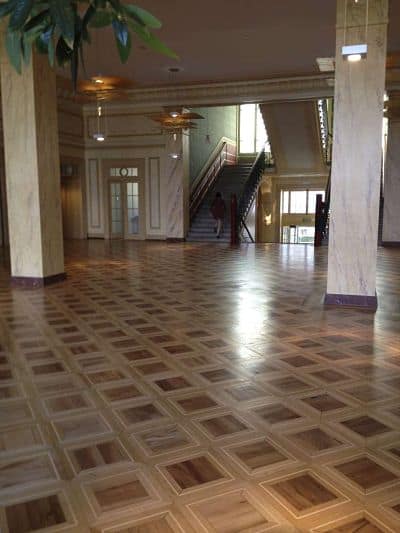This is a phenomenally impersonal and detached forum for addressing what really are issues of life and death for millions of people…. The meeting itself reinforced this detachment, with its ungodly amount of minutiae and complete absence of any emotion whatsoever. This is unabashedly, and unmistakably, an insider’s club.
This is how my research assistant described her first experiences of following the sessions of the Human Rights Committee.
I had asked her to monitor a few sessions before setting off to do background research to accompany my participant observation, and I have to say that watching her expression as she sat down trying to figure out what was transpiring in front of her in the surreal ‘UN reality’ humored me. Although being at the start of my own fieldwork, I had still grown enough of an ‘insider’ to have left my own first impressions behind me as I was now, by contrast, examining the sessions with the most intense interest. Thus her impatience of not having a clue of what was going on was the most welcome reminder of how my own perception had changed, and why.
Admittedly, nothing about my assistant’s first exposure to the grand organization had favored great enthusiasm. By the time she finally made her way to the audience seats in the Conference room of the Palais Wilson, she was already quite annoyed – it turned out that despite of carefully stating out that she was coming to follow the session of the Human Rights Committee, she had at the Gate of Pregny at the Palais des Nations been given a badge to follow the ongoing session of the Human Rights Council. She discovered this issue only upon arriving at the Palais Wilson where the security guards refused to let her in, and I had to consequently try and pull the few strings that I knew of to get her in (at the end it worked out).
audience seats in the Conference room of the Palais Wilson, she was already quite annoyed – it turned out that despite of carefully stating out that she was coming to follow the session of the Human Rights Committee, she had at the Gate of Pregny at the Palais des Nations been given a badge to follow the ongoing session of the Human Rights Council. She discovered this issue only upon arriving at the Palais Wilson where the security guards refused to let her in, and I had to consequently try and pull the few strings that I knew of to get her in (at the end it worked out).
That it was the COUNCIL in specific for which she was issued a badge forms an ironic twist due to the complex inter-relations of the two bodies that my fieldwork had made me aware of – namely the Human Rights Committee monitoring compliance of state parties with the International Covenant on Civil and Political Rights (ICCPR) and the Human Rights Council, the UN body with the highest international profile that was formed to replace the widely criticized Human Rights Commission a while back. During its short existence the Council and its monitoring mechanism the Universal Periodic Review widely called the ‘UPR’ have gained surprisingly high visibility, posing a highly unsuspected challenge to many aspects of the UN treaty body system.
This challenge became embodied in an exchange that occurred at the opening session of the Committee’s 107th session in March this year. Although quite cursory in nature, I invest high significance on this exchange due to both the slot of the Committee’s program it occurred in, as well as due to the people in between whom it occurred, namely the Committee’s chairperson and the UN High Commissioner for Human Right who opened the session. The exchange, taking place around 30 minutes into the session, went as follows:
High Commissioner (to conclude her introductory speech): “I would like to stay here, but I have to go to the Human Rights Council, which you can imagine is a very entertaining place to be.”
Chairperson (after thanking the Commissioner): “We’ll try to ‘furnish’ our entertainment quality over the next three weeks here as well.
 What do I read into this exchange? To me it speaks of the enormous role that the UPR has acquired over recent years both in terms of concrete investments of labor, time and resources by state parties, an investment certainly reciprocated by vast attention and coverage, the kind that the Human Rights Committee could only wish for, by the global and national media. There is no doubt that all of these outcomes are the kind that the Committee would wish to achieve, yet very likely never will: the Committee, having been in existence already for several decades, has nothing left of any novelty value, and its continual review cycles offer few surprises – if we ignore the suspense of whether it will actually receive the reports that are scheduled for processing or whether state parties fall behind deadlines as has been somewhat of a regrettable norm; or whether they will actually be able to process these reports, meaning if the UN Secretariat has found the required time to prepare them which today is increasingly not the case.
What do I read into this exchange? To me it speaks of the enormous role that the UPR has acquired over recent years both in terms of concrete investments of labor, time and resources by state parties, an investment certainly reciprocated by vast attention and coverage, the kind that the Human Rights Committee could only wish for, by the global and national media. There is no doubt that all of these outcomes are the kind that the Committee would wish to achieve, yet very likely never will: the Committee, having been in existence already for several decades, has nothing left of any novelty value, and its continual review cycles offer few surprises – if we ignore the suspense of whether it will actually receive the reports that are scheduled for processing or whether state parties fall behind deadlines as has been somewhat of a regrettable norm; or whether they will actually be able to process these reports, meaning if the UN Secretariat has found the required time to prepare them which today is increasingly not the case.
Of this particular brand of ‘excitement’ most recent was offered by the US, scheduled to have its report processed in the ongoing 109th session of the Committee. ‘Buzz’ about this event had accompanied both of the previous sessions of the Committee this year. In March I remember seeing groups of NGOs gathering in the cafeteria of the Cafe WIlson, oozing the kind of effectiveness that felt intimidating even with no direct contact with the groups. The NGOs had flown into Geneva for the adoption of the ‘List of Issues’ that was adopted by the Committee in March, and rumour has it that their trip was well worth it: later discussions with US NGOs suggested that they were highly effective in lobbying for the issues to be considered by the Committee.
Due to the widespread interest awakened by the report of the US – not to mention the massive NGO delegation that was supposed to include well over a hundred members – the proceeding of the report had been scheduled for a vast conference room at the Palais des Nations instead of the customary and much smaller conference room of Palais Wilson. Thus everything was set for an important and exciting exchange. Yet this never became: only a week before due date the US suddenly announced that due to the ongoing government shutdown it would cancel also its appearance in front of the Committee, and thus all the expectations for entertainment were transformed into tangible sentiments of disappointment.
In addition the work of the Committee, as well as the other UN treaty bodies, face sever ‘backlogs’ both in state reports and even more importantly, in individual communications submitted by nationals of state parties, leading the Committee in another instance to discuss whether these backlogs will even compromise its relevance. That the Committee finds itself in an untenable position becomes evident from almost every session where both the Chairman and individual Committee members seize opportunities to highlight the dire need for additional resources both for the Secretariat to be able to prepare more reports for the Committee’s examination in each session, and the Committee itself to have two to three additional weeks annually for their session. To the casual observer it also becomes painfully evident that the Committee’s attempts to secure these needed additional resources were rejected by the General Assembly in the previous year. This year, following vivid discussions in a public session where the Committee addresses the issue of its working methods, it is jointly decided that this request will be repeated.
 However, it is simultaneously recognized that receiving these resources is unlikely due to the constant, and increasing pressures to ‘economize’ the Committee’s operations. In concrete terms this means pressures to rather reduce than increase the Committee’s budget; a proposal that was also at the heart of a proposal created and circulated a year or some earlier by the UN High Commissioner to unify all of the existing 9 treaty bodies into one body that would be in session continually. Although it looks uncertain whether this proposal will be realized – the sentiments against it were certainly high among both permanent staff at the Office for the High Commissioner and treaty body members themselves – the general currents in regards to treaty body operations appear thus to be on the side of downsizing rather than expanding.
However, it is simultaneously recognized that receiving these resources is unlikely due to the constant, and increasing pressures to ‘economize’ the Committee’s operations. In concrete terms this means pressures to rather reduce than increase the Committee’s budget; a proposal that was also at the heart of a proposal created and circulated a year or some earlier by the UN High Commissioner to unify all of the existing 9 treaty bodies into one body that would be in session continually. Although it looks uncertain whether this proposal will be realized – the sentiments against it were certainly high among both permanent staff at the Office for the High Commissioner and treaty body members themselves – the general currents in regards to treaty body operations appear thus to be on the side of downsizing rather than expanding.
These pressures are intensified by the undefined nature and concrete impact of treaty bodies. One part of this tension revolves around the complex relation of treaty bodies and law. Another problem is how to measure the impact of treaty body work, and that of the ‘constructive dialogue’ – their primary public ceremony – more specifically. Many Committee members bring up with disappointment on how states seem to often offer very little evidence of having actually considered the ‘Concluding Observations’ of treaty bodies. State bodies also on occasion notice how the same recommendations end up circulating from one set of Concluding Observations to the next in the following cycle.
Against these tensions this casual encounter between the Committee Chairperson and the UN High Commissioner for HUman Rights acquires thus far more somber undertones: it appears as no mere instance of rare jokes being made (the reference to “furnishing of entertainment quality”is an undisputed wry joke by the chairperson), but rather there is something much more important at stake. It is actually disheartening to think that this body of ‘international experts’ who have travelled the world to be present, abandoned their regular professional activities and private lives for the duration of an entire month, should be set off to the forthcoming intense weeks of the Committee work, only to be greeted by this message by the High Commissioner that, in fact, to her and thus perhaps to her office, the ‘real action’ occurs elsewhere – in a place near but so far.
 And simultaneously there is undoubtedly also some truth in this exchange: whereas I have not yet witnessed the action of the UPR in person, by all accounts – although undoubtedly also in general a routinized ceremonial proceeding – the UPR offers at least the chance of the ‘unexpected’, the ‘emotional’ – the ‘entertaining’. This conception is, of course, very problematic for the Human Rights Committee in its continued efforts to reach the ‘real reality’ of real people in the world. And this is also where the reference to fireworks comes in: although a joke, at least some presence of something exciting, perhaps even spontaneous and unexpected is a crucial element for how the Committee can continue to engage people both within and beyond the UN, and also thus one of the key ways in which it can argue for its continued relevance. Thus, another way to see the Chairperson’s statement is as a wish for something of this nature to occur – another ironic twist as his wonderfully polished and generous tenor as the chair bringing reminders from a diplomatic era long-gone in its own right serves also to produce the opposite; that is a continued sense of professional engagement, of courtesy, and a comforting sense of the predictable.
And simultaneously there is undoubtedly also some truth in this exchange: whereas I have not yet witnessed the action of the UPR in person, by all accounts – although undoubtedly also in general a routinized ceremonial proceeding – the UPR offers at least the chance of the ‘unexpected’, the ‘emotional’ – the ‘entertaining’. This conception is, of course, very problematic for the Human Rights Committee in its continued efforts to reach the ‘real reality’ of real people in the world. And this is also where the reference to fireworks comes in: although a joke, at least some presence of something exciting, perhaps even spontaneous and unexpected is a crucial element for how the Committee can continue to engage people both within and beyond the UN, and also thus one of the key ways in which it can argue for its continued relevance. Thus, another way to see the Chairperson’s statement is as a wish for something of this nature to occur – another ironic twist as his wonderfully polished and generous tenor as the chair bringing reminders from a diplomatic era long-gone in its own right serves also to produce the opposite; that is a continued sense of professional engagement, of courtesy, and a comforting sense of the predictable.
These fieldnotes are based on my ongoing project examining UN human rights monitoring for which I am currently conducting fieldwork at the 109th session of the UN Human Rights Committee. In my earlier notes I have discussed arriving at the UN (click here to read) and how ‘real reality’ is transformed into ‘UN reality’ (click here to read). My reflections continue with NGO strategies and coalition building.





